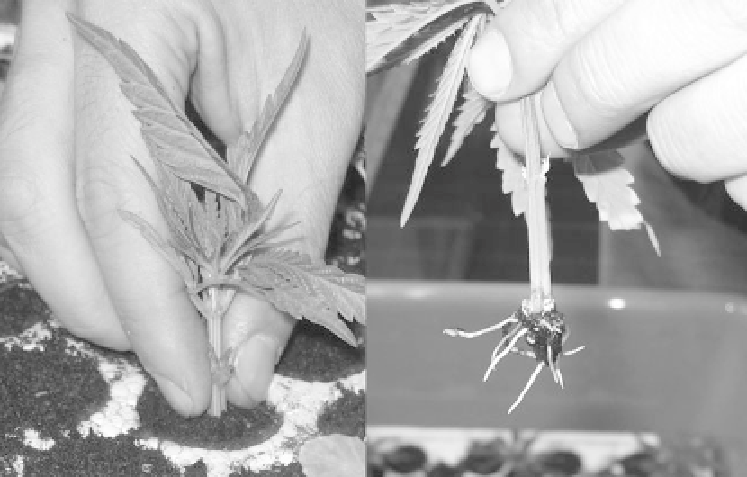Agriculture Reference
In-Depth Information
by pollen from male flowers growing nearby or
close enough to allow wind to carry the pollen.
Monoecious hemp undergoes 20-25% self-
pollination, but is usually treated by selectors as
the product of cross-pollination.
The vegetative multiplication of hemp is
practised in only a few special cases. A group
of plants may be produced from a single plant,
giving rise to a number of clones. This proce-
dure is called cloning (Fig. 4.5). Plants issuing
from the same clone are genetically identical
and will demonstrate the same characteristics
as the parent plant. In practice, vegetative mul-
tiplication is used only for reproduction in
greenhouses, often for drug production or
medicinal purposes.
The recently developed cultivation of
hemp tissues can also be viewed as a method
of vegetative reproduction.
those plants that correspond best to the pre-
scribed objectives. Selection has become the
most elaborate form of plant creation. The
creator must work with the materials at his or
her disposal and will select those characteristics
that are best suited to his or her needs.
Cultivated forms selected for production
and described as 'indigenous' have evolved
from their original wild hemp ancestors, under-
going a series of successive selections.
Mass selection remains one of the most
ancient procedures used for the selection of
hemp. This method was applied in such a
way that all the seed stock derived from
selected plants was sown in order to prepare
a new generation. This process was repeated
over several years. Farmer-selected landraces
originally evolved from wild hemp popula-
tions by mass selection. At the very
beginning of hemp breeding, cultivars were
obtained from landraces by selection,
resulting in improved landraces (Hoffmann,
1961). In Italy, Carmagnola was improved by
mass selection, leading to the development
of the cultivars Bolognese, Toscana and
Ferrarese (Ranalli, 2004). A similar scenario
was described for the breeding of Novosadska
konoplja (Berenji, 1992). Mass selection is
still used for the maintenance of registered
hemp cultivars.
Selection methods for hemp
The methods suitable for cross-pollination have
been adapted to hemp selection (Hoffman
et al
., 1970; Berenji and Sikora, 1996).
MULTIPLICATION
.
Selection is a process that
allows the proportion of desirable genotypes to
be increased. Successive generations are sub-
jected to a process of selection that chooses
Fig. 4.5.
Cloning hemp.

